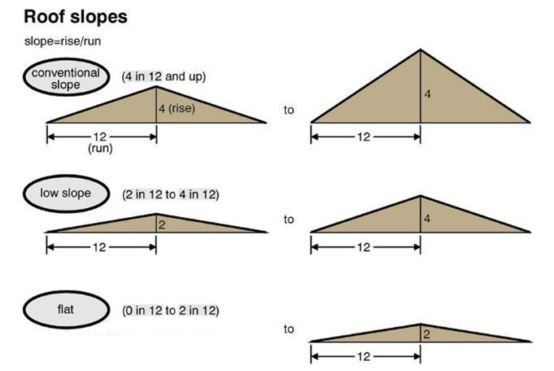It is easy to see why homeowners opt for shingles for roofing. Shingles are not that pricey if compared to other roofing options.
Installation of this roofing must be carefully done, though. Understanding the minimum roof slope is crucial for proper installation. Consulting with a roofing contractor can provide valuable insights into the requirements for your specific roof with a pitch.
Minimum Roof Slope for Asphalt and Shingle Roof
Before diving into a deeper discussion, such as the minimum slope for a shingle roof, it might be better to look at shingle roofing benefits beyond pricing and diversity. First of all, most houses tend to utilize shingles made out of asphalt.

It is because the material is durable enough. Besides, the asphalt material can reflect light, so your roof will not get heated up that easily.
What are the steps of installing a shingle roof? Let’s take a look at the following guide.
- Prepare for safety gear and the workstation’s safety.
- Calculate and learn why the slope is an important component.
- Prepare the roof deck for the project.
- Start the task from the upper side of the roof to the lower part. Install protection underneath the roof of the desk to prevent upward water movement.
- Install ice dam protection over the eaves. It should extend up to ¾ inches beyond the eaves. The valleys on the roof should also be coated to improve water-shedding protection on the surface.
- Install the roof underlayment overlapping the ice dam and water protector. This creates a secondary protection layer.
- Seal the valleys and the joints.
- Start installing the shingles on the roof by following package instructions. At this point, it is important to remember that the minimum roof slope for asphalt shingles must be fulfilled.
- Install caps for the hip and ridges.
Read also: How to Put a Ladder on a Sloped Roof Safely?
Some people may have difficulty grasping technical ideas like minimum roof slope for shingles. All buildings must adhere to the code regulated by the local government. Since the roof gets exposed to water and snow in a cold climate, the roof should be able to let it slide down. If not, the water and snow will accumulate on top and wear down one’s roof too quickly.
Thus, the minimum roof slope for shingles must be fulfilled first. The minimum slope is typically measured at 2-12 inches for asphalt roof shingles. This pitch requirement ensures that water flows off the roof efficiently, reducing the risk of water damage.
A roof with such a slope has quite the angle to let water and snow run. However, since it is not that steep, the flow will not be as quick as the steeper roof. The slope measurement might not be obvious. It is not that hard to calculate.
When installing shingles on a low slope or flat roof, it’s essential to adhere to the shingle manufacturer’s installation instructions. These guidelines ensure the shingles perform effectively, especially in protecting against elements like ice, water, and snow.
Roof Systems and Slope Considerations
Different roof systems have varying minimum roof pitch requirements. For instance, some systems may require a steeper slope to effectively shed water, while others can be installed on lower slopes. Always check with your roofing contractor to determine the best shingles for your roof’s pitch.
How to Measure Roof Slope
To measure the roof slope, a homeowner can make a ratio by dividing rise by run. The rise is the measurement from the horizontal truss toward the top of a roof. Meanwhile, the run is the length of the horizontal roof truss. According to this standard, three types of slopes are known by the general public.
To accurately measure your roof’s slope, you can use a simple formula: divide the roof’s vertical rise (in inches) over a 12-inch horizontal distance. This measurement helps determine whether your roof meets the minimum slope requirements for the shingle type.
Flat roof slope
The measurement of flat roof slope varies from 0-12 inches to 2-12 inches. However, asphalt shingle roofing should fulfill the minimum roof slope because installing them at a flatter angle is impossible. In a flat roof slope, a homeowner must find ways to ensure water will run down safely.
Low roof slope
The measurement should range from 2-12 inches to 4-12 inches to be dubbed as a low roof slope. Since it is steeper than the low roof, water will run much quicker down. It is easy to install asphalt shingles on such roof slopes.
Conventional roof slope
The standard roof slope tends to measure beyond 4-12 inches. Roof shapes may vary a lot depending on the slope measure. This type of roofing easily fulfills the building code. However, a homeowner must take extra measures to prevent water from running down too quickly. It is especially applied on a very steep slope.
As you can see, constructing a shingle roof is not that simple. There are measurements to be taken, so planning becomes quite important. It will be helpful to work together with an experienced consultant despite how easy DIY shingle installation is.
Luckily, there are special apps that can help measure slope. Manufactured shingles also come with a chart that includes the minimum roof slope for shingles.


